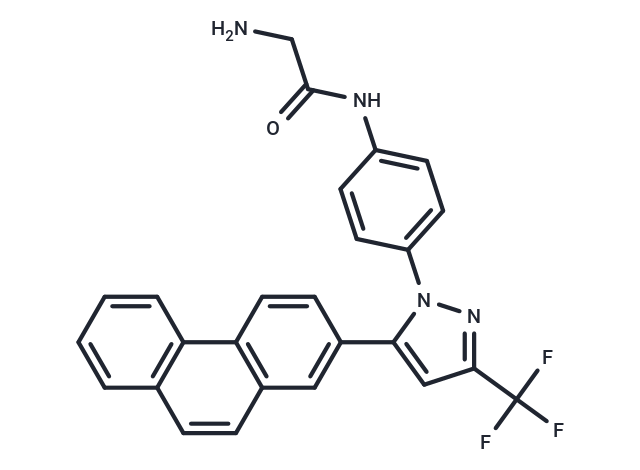Shopping Cart
Remove All Your shopping cart is currently empty
Your shopping cart is currently empty
Osu03012 (AR-12) is an orally bioavailable, small-molecule, celecoxib-derived inhibitor of phosphoinositide-dependent kinase-1 (PDK1) with potential antineoplastic activity.

| Pack Size | Price | USA Warehouse | Global Warehouse | Quantity |
|---|---|---|---|---|
| 2 mg | $31 | In Stock | In Stock | |
| 5 mg | $47 | In Stock | In Stock | |
| 10 mg | $79 | In Stock | In Stock | |
| 25 mg | $146 | In Stock | In Stock | |
| 50 mg | $277 | In Stock | In Stock | |
| 100 mg | $367 | In Stock | In Stock | |
| 200 mg | $477 | In Stock | In Stock | |
| 500 mg | $782 | - | In Stock | |
| 1 mL x 10 mM (in DMSO) | $47 | In Stock | In Stock |
| Description | Osu03012 (AR-12) is an orally bioavailable, small-molecule, celecoxib-derived inhibitor of phosphoinositide-dependent kinase-1 (PDK1) with potential antineoplastic activity. |
| Targets&IC50 | PDK1:5 μM |
| In vitro | In the MDA-MB-435/LCC6 xenograft model, OSU-03012 significantly reduced the expression of EGFR protein in tumors while also inhibiting the binding of YB-1 to the EGFR promoter. In Huh7 xenografts, OSU-03012 (200 mg/kg) effectively inhibited tumor cell growth. Similarly, oral administration of OSU-03012 in the HMS-97 neurofibroma xenograft model suppressed cell growth. |
| In vivo | At concentrations of 3-5 μM, OSU-03012 can completely inhibit the growth of various tumor cells. In thyroid cancer cells (NPA, WRO, and ARO cells), OSU-03012 acts as an ATP-competitive inhibitor, inhibiting cell proliferation and migration, and inducing apoptosis by suppressing PAK activity and AKT phosphorylation. In hepatocellular carcinoma cell lines (Huh7, Hep3B, and HepG2 cells), OSU-03012 (IC50<1 μM) inhibits cell growth, notably inducing autophagy in Huh7 cells. Additionally, in glioblastoma and PC-3 cells, OSU-03012 promotes apoptosis. |
| Kinase Assay | PDK-1 Kinase Assay: This in vitro assay is performed using a PDK-1 kinase assay kit. This cell-free assay is based on the ability of recombinant PDK-1, in the presence of DMSO vehicle or OSU-03012, to activate its downstream serum- and glucocorticoid-regulated kinase which, in turn, phosphorylates the Akt/serum- and glucocorticoid-regulated kinase-specific peptide substrate RPRAATF with [γ-32P]ATP. The 32P-phosphorylated peptide substrate is then separated from the residual [γ-32P]-ATP by using P81 phosphocellulose paper and quantitated in a scintillation counter after three washes with 0.75% phosphoric acid. |
| Cell Research | The effect of OSU-03012 on PC-3 cell viability is assessed by using the 3-(4,5-dimethylthiazol-2-yl)-2,5-diphenyl-2H-tetrazolium bromide assay in six replicates. Cells are grown in 10% FBS- supplemented RPMI 1640 in 96-well, flat-bottomed plates for 24 hours. They are exposed to various concentrations of OSU-03012 (0-10 μM) dissolved in DMSO (final concentration ≤0.1%) in 1% serum-containing RPMI 1640 for different time intervals (~72 hours). Controls receive DMSO vehicle at a concentration equal to that in OSU-03012-treated cells. The medium is removed and replaced by 200 μL of 0.5 mg/mL 3-(4,5-dimethylthiazol-2-yl)-2,5-diphenyl-2H-tetrazolium bromide in 10% FBS-containing RPMI 1640. The cells are incubated in the CO2 incubator at 37 °C for 2 hours. Supernatants are removed from the wells, and the reduced 3-(4,5-dimethylthiazol-2-yl)-2,5-diphenyl-2H-tetrazolium bromide dye is solubilized in 200 μL DMSO per well. Absorbance at 570 nm is determined by using a plate reader.(Only for Reference) |
| Synonyms | Osu-03012, Osu 03012, AR-12 |
| Molecular Weight | 460.45 |
| Formula | C26H19F3N4O |
| Cas No. | 742112-33-0 |
| Smiles | NCC(=O)Nc1ccc(cc1)-n1nc(cc1-c1ccc2c(ccc3ccccc23)c1)C(F)(F)F |
| Relative Density. | 1.369g/cm3 |
| Color | White |
| Appearance | Solid |
| Storage | Powder: -20°C for 3 years | In solvent: -80°C for 1 year | Shipping with blue ice/Shipping at ambient temperature. | |||||||||||||||||||||||||||||||||||
| Solubility Information | Ethanol: < 1 mg/mL (insoluble or slightly soluble) H2O: < 1 mg/mL (insoluble or slightly soluble) DMSO: 120 mg/mL (260.61 mM), Sonication is recommended. | |||||||||||||||||||||||||||||||||||
| In Vivo Formulation | 10% DMSO+40% PEG300+5% Tween 80+45% Saline: 2 mg/mL (4.34 mM), Sonication is recommended. Please add the solvents sequentially, clarifying the solution as much as possible before adding the next one. Dissolve by heating and/or sonication if necessary. Working solution is recommended to be prepared and used immediately. The formulation provided above is for reference purposes only. In vivo formulations may vary and should be modified based on specific experimental conditions. | |||||||||||||||||||||||||||||||||||
Solution Preparation Table | ||||||||||||||||||||||||||||||||||||
DMSO
| ||||||||||||||||||||||||||||||||||||
| Size | Quantity | Unit Price | Amount | Operation |
|---|

Copyright © 2015-2025 TargetMol Chemicals Inc. All Rights Reserved.